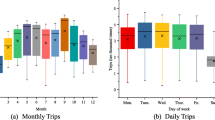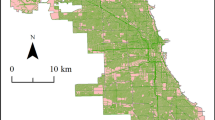Abstract
Bike Share Toronto is Canada’s second largest public bike share system. It provides a unique case study as it is one of the few bike share programs located in a relatively cold North American setting, yet operates throughout the entire year. Using year-round historical trip data, this study analyzes the factors affecting Toronto’s bike share ridership. A comprehensive spatial analysis provides meaningful insights on the influences of socio-demographic attributes, land use and built environment, as well as different weather measures on bike share ridership. Empirical models also reveal significant effects of road network configuration (intersection density and spatial dispersion of stations) on bike sharing demands. The effect of bike infrastructure (bike lane, paths etc.) is also found to be crucial in increasing bike sharing demand. Temporal changes in bike share trip making behavior were also investigated using a multilevel framework. The study reveals a significant correlation between temperature, land use and bike share trip activity. The findings of the paper can be translated to guidelines with the aim of increasing bike share activity in urban centers.




Similar content being viewed by others
Notes
An ideal indicator if how the thermal environment affects human wellbeing is the Physiologically Equivalent Temperature (PET) (Matzarakis and Amelung 2008). However, the calculation of the PET requires variables such as vapor pressure, mean radiant temperature, metabolic rate and the physical work output of the bike share user. Thus, due to data limitations, the perceived temperature described above was instead adopted.
Some origin destination (OD) pairs of bike share stations registered a very low number of daily trip counts. Therefore, OD trips were aggregated monthly.
References
Bachand-Marleau, J., Lee, B.H., El-Geneidy, A.M.: Better Understanding of Factors Influencing Likelihood of Using Shared Bicycle Systems and Frequency of Use. Transportation Research Record: Journal of the Transportation Research Board, No. 2314, Transportation Research Board of the National Academics, Washington, D.C., pp. 66–71 (2012)
Bates, D., Maechler, M., Bolker, B., Walker, S.: lme4: Linear mixed-effects models using Eigen and S4. 2014. R package version 1.1-7, http://CRAN.Rproject.org/package=lme4. Accessed 20 Nov 2014
Bike Share Toronto, City of Toronto. http://www1.toronto.ca/wps/portal/contentonly?vgnextoid=9224970aa08c1410VgnVCM10000071d60f89RCRD (2012). Accessed 20 July 2014
Buck, D., Buehler, R.: Bike lanes and other determinants of capital bike share trips. In 91st annual meeting of the Transportation Research Board, Washington, D.C. (2012)
Burden, A.M., Barth, R.: Bike-Share Opportunities in New York City. Department of City Planning, New York (2009)
Curran, A.: Translink Public Bike System Feasibility Study. Quay Communications Inc, Vancouver (2008)
Daddio, D.W:. Maximizing Bicycle Sharing: An Empirical Analysis of Capital Bikeshare Usage. University of North Carolina at Chapel Hill, Department of City and Regional Planning (2012)
DeMaio, P.: Bike-sharing: history, impacts, models of provision, and future. J. Public Transp. 12(4), 41–56 (2009)
DMG. Data Management Group: Transportation Tomorrow Survey. Joint Program in Transportation, University of Toronto (2011)
Ewing, R., Cervero, R: Travel and the built environment: a synthesis. Transportation Research Record: Journal of the Transportation Research Board. No. 1780. Transportation Research Board of the National Academics, Washington, D.C., pp. 87–114 (2001)
Environment Canada. Glossary. http://climate.weather.gc.ca/glossary_e.html (2014). Accessed 20 July 2014
Fishman, E., Washington, S., Haworth, N.: Bike share: a synthesis of the literature. Trans. Rev. 33(2), 148–165 (2013)
Fishman, E., Washington, S., Haworth, N., Watson, A.: Factors influencing bike share membership: an analysis of Melbourne and Brisbane. Transp. Res. Part A: Policy Pract. 71, 17–30 (2015)
Fraser, S.D., Lock, K.: Cycling for transport and public health: a systematic review of the effect of the environment on cycling. Eur. J. Public Health 21(6), 738–743 (2011)
Gebhart, K., Noland, R.B.: The impact of weather conditions on capital bikeshare trips. Transportation 41(6), 1205–1225 (2014)
Gelman, A., Hill, J.: Data analysis using regression and multilevel/hierarchical models, Cambridge University Press (2006)
Gregerson, J., Hepp-Buchanan, M., Rowe, D., Vander Sluis, J., Wygonik, E., Xenakis, M., McCormack, E.: Seattle Bicycle Share Feasibility Study. University of Washington, College of Buil Environment, Department of Urban Planning and Design (2011)
Google Maps. Google Maps API. https://www.google.ca/maps (2014)
Habib, K.M.N., Mann, J., Mahmoud, M., Weiss, A.: Synopsis of bicycle demand in the City of Toronto: application of an integrated econometric model with latent variables. Transp. Res. Part A: Policy Pract. 70, 67–80 (2015)
Hampshire, R.C., Marla, L.: An Analysis of Bike Sharing Usage: Explaining Trip Generation and Attraction from Observed Demand. In 91st Annual Meeting of the Transportation Research Board, Washington, DC (2012)
Imani, A.F., Eluru, N., El-Geneidy, A.M., Rabbat, M., Haq, U.: How Does Land-Use and Urban Form Impact Bicycle Flows-Evidence from the Bicycle-Sharing System (BIXI) in Montreal. In Transportation Research Board 93rd Annual Meeting (2014)
Krykewycz, G.R., Puchalsky, C.M., Rocks, J., Bonnette, B., Jaskiewicz, F.: Defining a primary market and estimating demand for major bicycle-sharing program in Philadelphia, Pennsylvania. Transportation Research Record: Journal of the Transportation Research Board, No. 2143, Transportation Research Board of the National Academics, Washington, D.C., pp. 117–124 (2010)
Mahmoud, M., El-Assi, W., Habib, K.M.N., Shalaby, A.: How Active Modes Compete with Motorized Modes in High-Density Areas: A Case Study of Downtown Toronto. In Canadian Transportation Research Forum 50th Annual Conference, Montreal, Quebec (2015)
Matzarakis, A., Amelung, B.: Physiological equivalent temperature as indicator for impacts of climate change on thermal comfort of humans. Seas. Forecast. Clim. Change Human Health. pp. 161–172 (2008)
Muarer, L.K.: Suitability Study for a Bicycle Sharing Program in Sacramento, California. University of North Carolina at Chapel Hill, Department of City and Regional Planning (2011)
Nair, R., Miller-Hooks, E., Hampshire, R.C., Busic, A.: Large-scale vehicle sharing systems: analysis of Vélib’. Int. J. Sustain. Transp. 7(1), 85–106 (2013)
National Capital Comission: Reasibility study for the implementyation of a bike share service in Ottawa-Gatineau. http://www.ncc-ccn.gc.ca/sites/default/files/pubs/Study-Implementation-Bike-Share-Ottawa-Gatineau-Nov-2009.pdf (2009). Accessed December 2015
O’brien, R.M.: A caution regarding rules of thumb for variance inflation factors. Qual. Quant. 41(5), 673–690 (2007)
Owen, A. D., Phillips, G. D. A.: The characteristics of railway passenger demand. An econometric investigation. Journal of Transport Economics and Policy, pp. 231–253 (1987)
Pucher, J., Buehler, R., Seinen, M.: Bicycling renaissance in North America? An update and re-appraisal of cycling trends and policies. Transp. Res. Part A: Policy Pract. 45(6), 451–475 (2011)
Rixey, R.A., Station-Level Forecasting of Bikesharing Ridership. Transportation Research Record: Journal of the Transportation Research Board, No. 2387, Transportation Research Board of the National Academics, Washington, D.C., pp. 46–55 (2013)
Saelens, B.E., Sallis, J.F., Frank, L.D.: Environmental correlates of walking and cycling: findings from the transportation, urban design, and planning literatures. Ann. Behav. Med. 25(2), 80–91 (2003)
Saneinejad, S., Roorda, M.J., Kennedy, C.: Modelling the impact of weather conditions on active transportation travel behaviour. Transp. Res. Part D: Transp. Environ. 17(2), 129–137 (2012)
Service in Ottawa-Gatineau. A Study commissioned for the National Capital Commission (NCC), the Ville de Gatineau, and the City of Ottawa and conducted by Market Research Corporation, MMM Group Ltd., Meloshe & Associates Ltd, and Williamson Consulting Inc. City of Ottawa (2009)
Shaheen, S.A., Cohen, A.P., Martin, E.W.: Public Bikesharing in North America. Transportation Research Record: Journal of the Transportation Research Board, No. 2387, Transportation Research Board of the National Academics, Washington, D.C., pp. 83–92 (2013)
StatCan.: Proportion of workers commuting to work by car, truck or van, by public transit, on foot, or by bicycle, census metropolitan areas, 2011. Table 1.a. http://www12.statcan.gc.ca/nhs-enm/2011/assa/99-012-x/2011003/tbl/tbl1a-eng.cfm (2011). Accessed December 2015
Toronto Bike Plan - New Strategic Directions. Transportation Services, Toronto. http://www.toronto.ca/legdocs/mmis/2009/pw/bgrd/backgroundfile-21588.pdf (2009). Accessed 20 July 2014
Toronto Cycling Statistics, 2012. City of Toronto. http://www1.toronto.ca/wps/portal/contentonly?vgnextoid=caa5970aa08c1410VgnVCM10000071d60f89RCRD. Accessed 20 July 2014
Wang, X., Lindsey, G., Schoner, J. E., Harrison, A.. Modeling Bike Share Station Activity: The Effects of Nearby Businesses and Jobs on Trips To and From Stations. Transportation Research Record: Journal of Transportation Research Board, No. 43(44) Transportation Research Board of the National Academics, Washington, D.C., p. 45 (2012)
Winters, M., Babul, S., Becker, H.J., Brubacher J.R., Chipman, M., et al.: Safe cycling: how do risk perceptions compare with observed risk? Can. J. Public Health 103(9), eS42–eS47 (2012)
Acknowledgments
This research was funded through an NSERC Engage project. Authors are grateful to the City of Toronto for facilitating data access as well as comments/suggestions. However, the views and opinions express in the paper belong only to the authors.
Author information
Authors and Affiliations
Corresponding author
Appendices
Appendix 1: Literature review summary of related bike share studies
Author(s) | Location | Method | Time of year | Significant findings |
|---|---|---|---|---|
Bachand-Marleau et al. (2012) | Montreal, Canada | Online Survey | April to November | Proximity of docking stations to residential housing increases bike share trip frequency |
Gebhart and Noland (2014) | Washington D.C., USA | System Ridership Data | Year round Data | Reduced ridership was correlated with cold temperatures, rain, and high humidity levels |
Buck and Buehler (2012) | Washington D.C., USA | System Ridership Data | September to March | Station proximity to bicycle lanes may increase ridership |
Daddio (2012) | Washington D.C., USA | System Ridership Data | October | Proximity to retail outlets and the metro rail was positively correlated with trip generation. Locating stations away from the center of the bike share system tended to reduce ridership |
Wang et al. (2012) | Minnesota, USA | System Ridership Data | April to November | Station proximity to high job density and food serving enterprises was found to be correlated with higher ridership levels |
Rixey (2013) | Washington D.C., Denver, Minnesota | System Ridership Data | Year Round Data | Population density, retail density, education level of riders, proximity of station to other bike share stations were found to be positively correlated with increase in bike share use |
Nair et al. (2013) | Paris, France | System Ridership Data | March to July | Bike share ridership was positively correlated with station proximity to transit stops |
Hampshire and Marla (2012) | Barcelona, Spain | System Ridership Data | May to September | Population and employment density were found to be correlated with higher public bicycle use |
Imani et al. (2014) | Montreal, Canada | System Ridership Data | April to November | Station proximity to major roads was negatively correlated with ridership. Many smaller stations optimally distributed around the service area can lead to greater ridership as opposed to a few large stations |
Appendix 2: Multivariable Regression model variance inflation factor analysis
Appendix 3: Linear Mixed Effects Models’ Table of Results
See Tables 8, 9, 10, 11 and 12.
Rights and permissions
About this article
Cite this article
El-Assi, W., Salah Mahmoud, M. & Nurul Habib, K. Effects of built environment and weather on bike sharing demand: a station level analysis of commercial bike sharing in Toronto. Transportation 44, 589–613 (2017). https://doi.org/10.1007/s11116-015-9669-z
Published:
Issue Date:
DOI: https://doi.org/10.1007/s11116-015-9669-z




